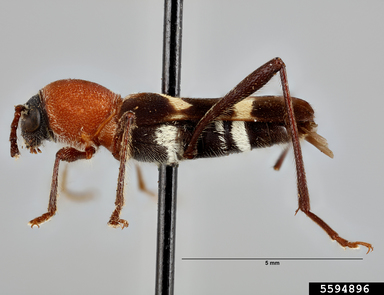
EPPO Alert List – Xylotrechus pyrrhoderus
(Coleoptera: Cerambycidae)
Why
Xylotrechus pyrrhoderus (Coleoptera: Cerambycidae) originates from Asia and is a borer of grapevine (Vitis spp.) and other Vitaceae. In 2020, it was detected for the first time in North America, in Massachusetts (US) on wild grapes. In its native range, X. pyrrhoderus is a pest of grapevine. Considering the economic importance of grapevine in the EPPO region, and the fact that this insect has recently been introduced into another continent, the EPPO Secretariat thought that X. pyrrhoderus could usefully be added to the EPPO Alert List.
Where
EPPO region: absent.
Asia: China (Anhui, Beijing, Chongqing, Fujian, Gansu, Guangdong, Guangxi, Guizhou, Henan, Hubei, Jiangsu, Jiangxi, Jilin, Liaoning, Neimenggu, Shaanxi, Shandong, Shanghai, Shanxi, Sichuan, Zhejiang), Japan (Honshu, Kyushu, Shikoku), Korea Democratic People's Republic, Korea (Republic of).
North America: USA (Massachusetts).

Xylotrechus pyrrhoderus - Paul Langlois (bugwood.org)
On which plants
Ampelopsis brevipedunculata, Parthenocissus tricuspidata, Vitis vinifera.
Damage
Larvae feed inside vines and branches, preferring healthy and robust shoots. As a consequence of larval feeding and boring activities, the shoot beyond the feeding point withers and dies. Dark sap may be observed oozing from infestation sites. In Japan, X. pyrrhoderus has one generation per year. Adults emerge in August and September and live during approximately a week. Mating behaviour has been studied and sex pheromones have been identified. Eggs are laid in the bark, or between the buds and the leaf petiole. After 5 days, newly hatched larvae penetrate twigs through the buds. Larvae overwinter within shoots and resume feeding in spring.
In its native range, X. pyrrhoderus is considered to be a major pest of grapevine, which can reduce grape production by 10 to 20%. In Massachusetts, it has been found on wild grapes and at present, no particular damage has been reported but growers have been invited to report any sightings.
Dissemination
No data is given on the flight capacities of X. pyrrhoderus. Over long distances, the insect can be transported on planting material. As it is an attractive insect, beetles may be traded as such. The pathway of introduction into the USA is unknown.
Pathways
Plant for planting of Ampelopsis brevipedunculata, Parthenocissus tricuspidata, and Vitis vinifera, grapevine wood? from countries where X. pyrrhoderus occurs.
Possible risks
Grapevine is a crop of major economic importance in the EPPO region. X. pyrrhoderus is considered to be a pest in its native range, although there is little data available in the literature on this insect. Given its hidden mode of life, X. pyrrhoderus is difficult to detect on infested plants. For the moment, it seems that no particular damage is observed in Massachusetts. Nevertheless, recent experience with a similar species, X. chinensis (EPPO Alert list) which has been introduced from Asia into the EPPO region, causing mortality on Morus species, suggests a cautious approach may be needed. Imports of Vitis planting material from outside the EPPO region are usually prohibited, but this is not necessarily the case for the other hosts, Ampelopsis brevipedunculata, and Parthenocissus tricuspidata which are ornamental plants.
Sources
Ashihara W (1982) [Seasonal life history of the grape tiger borer Xylotrechus pyrrhoderus]. Bulletin of the Fruit Tree Research Station Series E 4, 91-112 (in Japanese).
Clausen CP (1931) Insects injurious to agriculture in Japan. USDA Circular no. 168, 116 pp.
Han Y, Lyu D (2010) Taxonomic review of the genus Xylotrechus (Coleoptera: Cerambycidae: Cerambycinae) in Korea with a newly recorded species. Korean Journal of Applied Entomology 49(2), 69-82.
Iwabuchi K (1982) Mating behavior of Xylotrechus pyrrhoderus Bates (Coleoptera: Cerambycidae) I. Behavioral sequences and existence of the male sex pheromone. Applied Entomology and Zoology 17(4), 494-500.
Kiyota R, Yamakawa R, Iwabuchi K, Hoshino K, Ando T (2009) Synthesis of the deuterated sex pheromone components of the grape borer, Xylotrechus pyrrhoderus. Bioscience, Biotechnology and Biochemistry 73(10), 2252–2256.
Lin M, Ge S, Xiao N (2021) A study of the genus Xylotrechus Chevrolat (Coleoptera: Cerambycidae) from Beijing, China. Entomotaxonomia 43(3), 20 pp. https://doi.org/10.11680/entomotax.2021021
Massachusetts Introduced Pests Outreach Blog. A pest to keep an eye out for: Grape borer beetle. https://massnrc.org/pests/blog/?p=3142
Sakai T, Nakagawa Y, Takahashi J, Iwabuchi K, Ishii K (1984) Isolation and identification of the male sex pheromone of the grape borer Xylotrechus pyrrhoderus Bates (Coleoptera: Cerambycidae). Chemistry Letters, 263-264.
USDA. Pest Alert. Grape borer beetle (Xylotrechus pyrrhoderus Bates). https://www.aphis.usda.gov/publications/plant_health/alert-grape-borer-beetle.pdf (accessed in June 2023).
Yoshitomi H, Matsuno S, Sakai M (2012) [List of the species of the order Coleoptera in Matsuyama City, Ehime Prefecture, Shikoku, Japan]. In: Ishikawa K (ed) Checklist of the Wild Animals, Fungi, and Plants of Matsuyama City. Committee for Surveys of Natural Environment of Matsuyama City, 105-166 (in Japanese)
EPPO RS 2023/136, 2024/145
